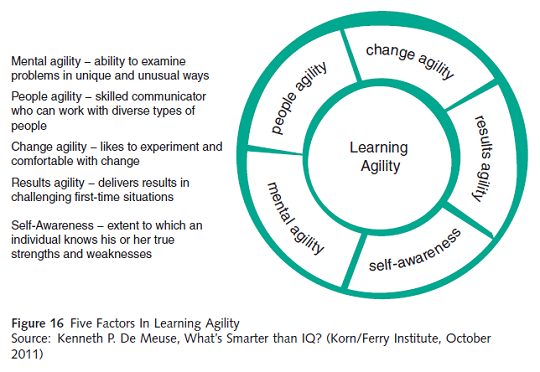What do executive search consultants look for in a candidate? Until 10 years ago, the answer was very simple: Results, results, and results. Past performance was considered to be the best predictor of future performance. No matter what, business is about creating results; they may be growth rates, market share gains, free cash flow or other key performance indicators. The foundation for a successful career is tangible or hardcore results and your reputation is the sum of your past performance. There’s no elevator to success – you have to take the stairs. In addition to that you may have excellent leadership and interpersonal competencies. At the end of the day you are measured by the value you create for your organization and your future career will depend on the potential value you will create for your new organization. But nowadays, there is more to the story than just performance and results.
I would like to touch on the fundamental concept of Learning Agility and explore it more in detail. The construct of Learning Agility consists of five dimensions:
- Mental Agility
- People Agility
- Change Agility
- Results Agility
- Self-Awareness.

Learning Agility is not correlated with age, gender, education, or other demographics – yet only 15% of the population is learning agile. It is a psychographic, not a demographic. However, there is evidence that Learning Agility increases with experience and career trajectory. People with low Learning Agility tend to focus on the destination whereas people with high Learning Agility focus on the journey.
The typical picture of a career person is that Results Agility ranks highest, followed by Mental Agility and People Agility. Most often the lowest score is Change Agility. What is needed to cope with change is mental plasticity and most of us are more or less content within the mold that formed us. Mental Agility is a broader concept than Intelligence. Sometimes too much intellectual horsepower looks like arrogance. Mentally agile people are able to connect the dots; they look for patterns and root causes, and can explain their thinking. An interesting finding is that the Results dimension includes the leadership behaviour most often associated with charisma and ability to show the way. So in all fairness your results include the leadership leverage that you perform through other people. Creating results is about making a positive impact on the behaviour of others. I do not believe in the old adage: “People are our most important asset”. As Jim Collins points out: “The right people are our most important asset” and the right people are those who produce results.
Reaching the top of a corporation requires ambition and hard work. It is a question of control as well as being able to cope with the long haul. In the process you will inevitably make some enemies but critique has a tendency to mute when the results speak for themselves. Practice makes perfect and through inexorable work discipline you can practice and become good at what you choose to focus on. Diligence and results are the best branding for any ambitious executive. Furthermore, successful leaders often dare to take the road less travelled and are willing to submit themselves, their situation, and their position to constant and various challenges.
Diversity is the precondition for creativity. In order to activate your creativity it is important to let yourself be provoked, challenged, and inspired by new contrasts. Next time you put on a jacket, try putting the other arm in the sleeve first. Your brain will start looking for a program that is simply not there. The energy that comes from breaking habits can be used to focus even more on your strengths and identify even more opportunities.
The business challenge is to be able to look beyond traditional industry classifications and systematically combine the key competencies of the corporation with creativity in order to gain new customers. Combining this with a clear identification of the employees with the highest potential gives an unbeatable cocktail.






2 responses
I think that yes, Learning
I think that yes, Learning Agility is the key indicator for future potential and indeed, all the research around this area shows that the more adaptable, flexible and open someone is to new experiences, the more successful they are. Of course, it depends on what you define as 'success', but it does lend weight to the view that L&D professionals need to start thinking about how they:
1. Leverage learning agility to their organisations advantage
2. Develop learning agility in the workforce in general.
A very interesting read – thank you for taking the time to pull it together.
Fiona
http://www.zostera.co
http://www.thematerialbank.co.uk
Emerging market growth and expansion
Learning agility is key differentiator in assessment, development and deployment of leadership talent in our organization across 23 countries in Africa, Middle East and Asia. We have integrated into all our talent economics and analytic processes, data and tools. Peopletree.com